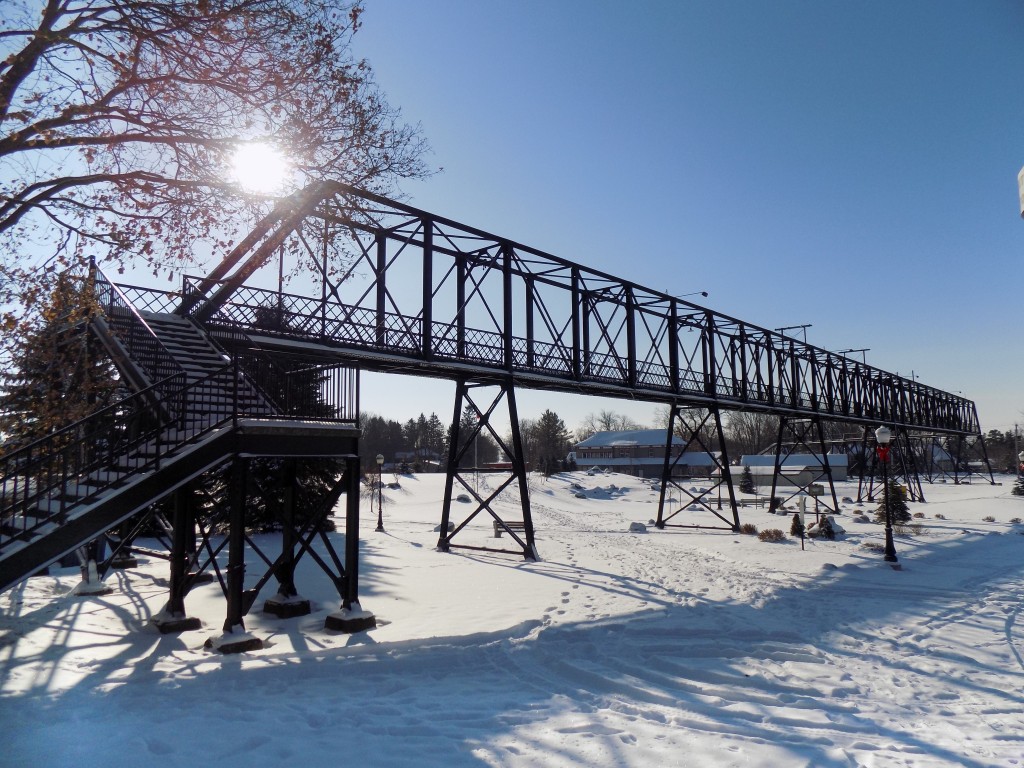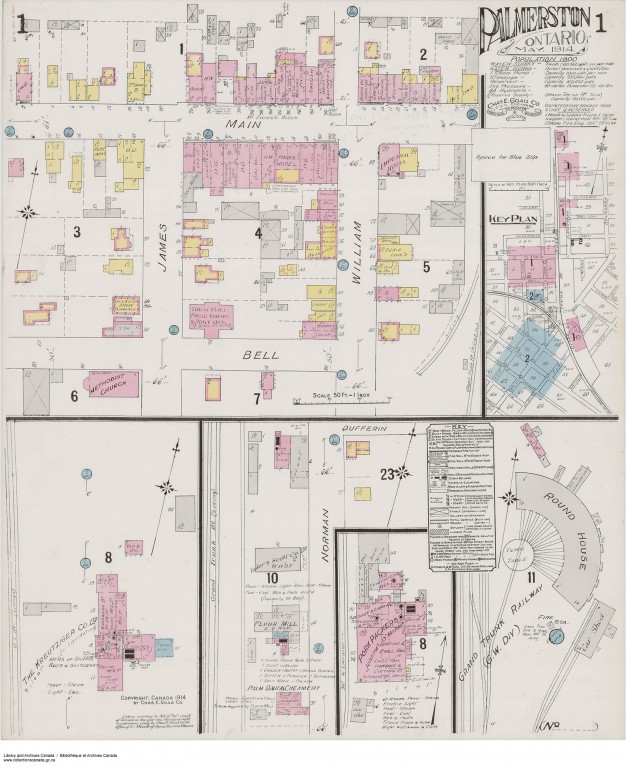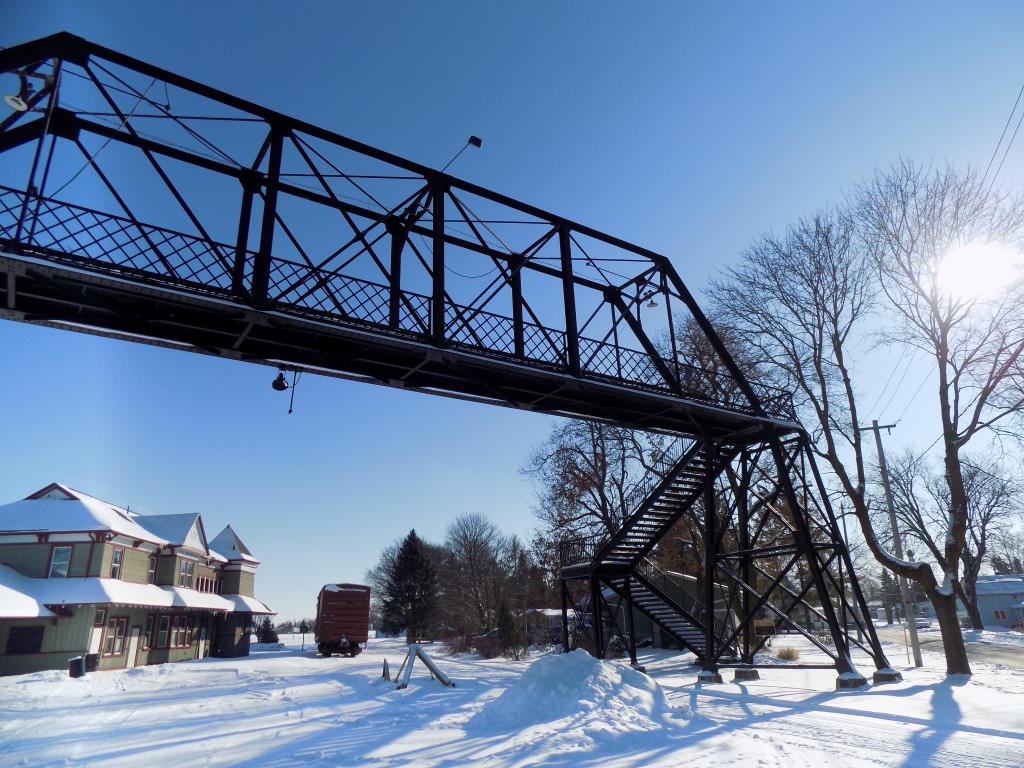One of Ontario’s last pedestrian railroad bridges

The pedestrian bridge over the former Canadian National Railways yard in Palmerston, Ontario. Photo: James Morgan
There are no railroad tracks through Palmerston, Ontario anymore, but a bridge that once crossed the tracks is still there. This small town located on the line between Wellington and Perth counties in southwestern Ontario is home to one of the last remaining railway pedestrian bridge in the province.
Palmerston was founded in 1870 and named Palmerston after Henry John Temple, the third Viscount Palmerston of Britain. In anticipation of the railroad, settlers and speculators began developing the surrounding townsite. Palmerston ended up being a major division point. The Grand Trunk, Great Western, Stratford and Huron, and Wellington, Grey, and Bruce Railways all passed through the community. Those railways eventually became part of Canadian National Railways (CN/CNR), which still exists today. Six CN subdivisions once all intersected in Palmerston, connecting cities and towns throughout the region. The railroad station was built in 1871 and due to a high amount of traffic, a second story was added in 1876. Palmerston was incorporated as a town in 1875. By 1903, the rail yard covered 23 acres and included 12 tracks, shops, a roundhouse, and a roundtable.

A map of Palmerston, Ontario in 1914 showing the rail yard in the center of town. Library and Archives Canada, R6990-577-6-E
The railroad hub gave Palmerston a place in pharmaceutical history. Local physician Dr. Alexander Stewart established The Vaccine Farm of Palmerston in 1885. The series of rail lines that passed through the town made it easy for vaccines to be quickly and safely transported to their destination within hours back in the days when refrigeration wasn’t always so reliable. The farm produced the first smallpox vaccines in Ontario using calves in its barn. It continued operating until 1916 when vaccine production was transferred to the University of Toronto.
A big rail yard in the middle of town presented a safety challenge. Walking across the tracks to get from one side of town to the other was dangerous, especially for children who had to get to school. The federal Railway Commission of Canada told the town council to close one of the streets that crossed the yard. In 1911, the Grand Trunk Railway began building a 700-foot-long truss pedestrian bridge across the rail yard, so Palmerston residents could safely walk across town by 1912.
Reliance on railroads decreased in the later part of the 20th Century. The nature of the railroad business changed sharply. Diesel locomotives replaced steam in the 1950s and Palmerston’s coal storage sheds were torn down. The roundhouse and roundtable were also removed. More and better highways led to transporting goods by trucks and travel by automobile became more popular than taking trains. The last CN passenger train went through Palmerston in 1970. The station remained open for freight until 1982 and one set of tracks continued to be used occasionally until they were removed in 1996.
The Town of Palmerston purchased the pedestrian bridge and railroad station in 1998. The town was dissolved into the Town of Minto in 1999. The bridge has been repaired and is open for pedestrian use from the spring to fall. The station is now a seasonal museum and features indoor and outdoor exhibits on Palmerston’s railroad past. The former yard is now a park in the center of the community.
Tags: canada, Palmerston Ontario, Perth County Ontario, railroad history, Town of Minto, vaccine history, Wellington County Ontario









There are tonnes of Pedestrian bridges across railways in Ontario:
Multiple near Exhibition Station in Toronto and Union Station
Burlington Ontario at Drury Lane
Guelph Ontario near Huron St
Multiple at GO and VIA Rail stations many recently constructed
Laking Gardens @ Royal Botanical Gardens (Plains rd) in Burlington Ont
Victoria rd in Hamilton
RBG Arboretum in Hamilton off Homestead ave
One for CP in Milton Ontario recently constructed near GO statiion but built for city not GO
… they are far from endangered.